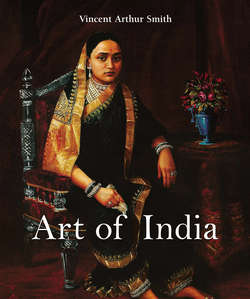Art of India

Реклама. ООО «ЛитРес», ИНН: 7719571260.
Оглавление
Vincent Arthur Smith. Art of India
India and its Art
The Mauryan Period
The Early Period
Architecture
Sculpture
The Kushan, Later Satavahna, and Ikshvaku Periods
Mathura
Amaravati
The Gupta Period
The Medieval Period in the North of India
Architecture: Cave-Temples and Temples
Sculpture: Medieval and Modern Objects
Painting: The Early Schools (Ajanta Caves)
The Medieval Period in the South of India
Architecture
Sculpture and Bronzes
Foreign Influences: the Early and Medieval Periods
The Islamic Period
The Indo-Islamic Styles of Architecture
The Indo-Islamic Decorative and Minor Arts
Coins, Gems, and Seals
Calligraphy and Decorative Reliefs
Lattices
Inlay and Mosaic
Tiles
The Indo-Islamic Styles of Painting
Gujarati Painting
Mughal Painting
Rajput Painting
Indian Paintings of the Twentieth Century
Timeline
Glossary
A
B
D
G
H/J
K
L
M
N
P
R
S
T
U
V
Y
Z
Bibliography
General
Architecture and Sculpture
Painting
Отрывок из книги
Maha-Janaka Jataka: Three of the queen’s maids respond to the unexpected news that the king plans to renounce his worldly goods and leave their mistress, late 6th century C. E., late Gupta period. Detail of a fresco. Ajanta caves (Cave I), near Aurangabad, Maharashtra.
In discussing Indian studies I am forced to acknowledge considerable diffidence arising from a survey of the huge bulk of material to be dealt with. In the face of this complexity I find myself inclined to rely on evidence that is subjective and therefore more or less unscientific, in which personal experience and interpretation is increasingly stressed. In speaking of India, a country that in its wide extent offers more beauty to the eyes than many others in the world, a descriptive vein may well be excused. India is multiple; neither geographically, ethnologically, nor culturally can it be considered a unity. This being so, I am led to suspect that the India of many writers is more imagination than fact, existing rather in pictorial expression than in reality.
.....
This cult of trees and tree spirits has a long history. In the sculptures of the early period (2nd-1st century B. C. E.) the Buddhas are represented only by symbols, among which are their distinctive trees. Gautama attained enlightenment seated beneath the Asvattha or pipal tree. In the Atharvaveda it is said that the gods of the third heaven are seated under the Asvattha and it may also be the ‘tree with fair foliage’ of the Rigveda under which Yama and the blessed are said to pass their time. In the Upanishads, the tree spirits have definitely materialized. They, like all things, are subject to rebirth. If the spirit leaves, the tree withers and dies, but the spirit is immortal. In the Jatakas, these tree spirits play a great part, being worshipped with perfumes, flowers, and food. They dwell in many kinds of trees but the banyan seems most popular. The scarlet-flowered silk-cotton tree and the sal tree as well as the pipal retain their sanctity today. The goddess of the sal is worshipped as giver of rain by the Oraons of Chota Nagpur, and in South Mirzapur the Korwas place the shrine of Dharti Mata under its branches. In the Jatakas more than once animal and even human sacrifices are spoken of in connexion with tree worship. Today the slaughter of roosters and goats is added to the more usual offering of flowers and sweetmeats, in extreme cases of propitiation.
The character and functions of these deities correspond closely to those of the mother goddesses of Southern India. Among these are Mariamma, goddess of smallpox, Kaliamma, of beasts and forest demons, Huliamma, a tiger goddess, Ghantalamma, who wears bells, and Mamillamma, she who sits beneath the mango tree.
.....